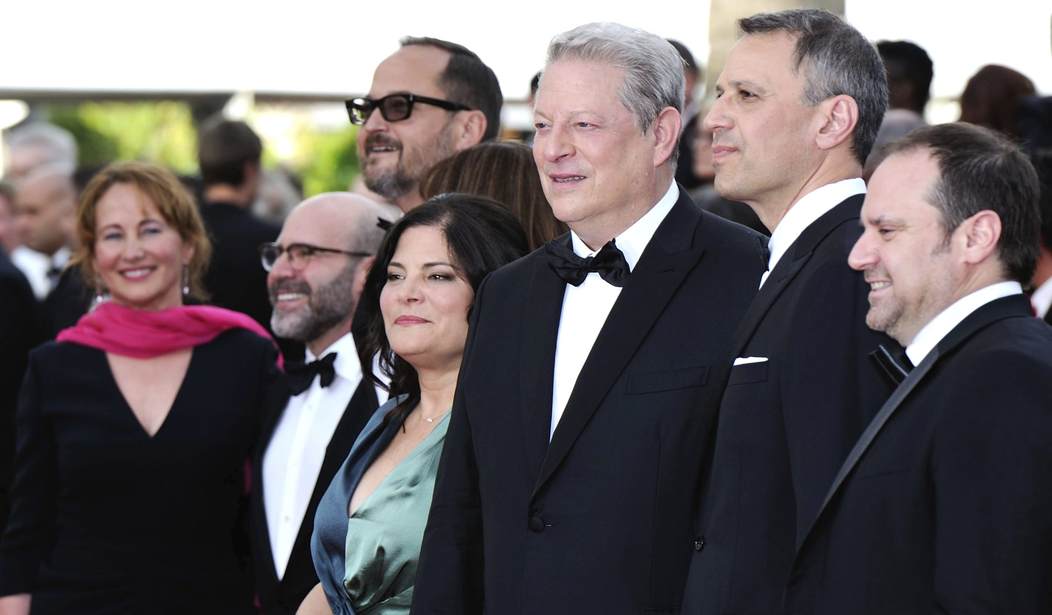WASHINGTON – Back with a sequel to An Inconvenient Truth, former Vice President Al Gore reflected on his 2006 prediction that “the world would reach a point of no return within 10 years” if “drastic measures” were not taken to combat climate change.
Gore was asked why he made that prediction in the first film and if he has another prediction to make about climate change now 11 years later.
“First of all, we’ve seen a lot of progress since the first movie came out. We have the Paris agreement now. The cost of renewable energy has come down so quickly that people are switching over. Unfortunately, some levels of the Earth system have crossed a point of no return,” Gore said during an interview with PJM on the green carpet of the An Inconvenient Sequel: Truth to Power screening Wednesday evening at the Newseum.
“The big chunk of the West Antarctic ice sheet, for example, makes a considerable amount of sea level rise inevitable in the future. But we still have the ability to stop short of other points of no return and we now have the solutions available to really solve this crisis. We need the political will, but political will is a renewable resource,” he added.
Gore recently said the U.S. still has time to “avoid catastrophe” related to the effects of climate change. PJM asked Gore what specific catastrophe he thinks might occur.
“I’m very optimistic because the entire world has now reached the agreement in Paris to go down to net-zero global warming pollution as early in the second half of this century as possible,” Gore replied. “Many countries are making dramatic changes now and, regardless of President Trump’s statement about the Paris agreement, our governors and mayors and business leaders are stepping up to fill the gap. I think we’re going to meet our obligations under the Paris agreement regardless of what he does.”
Jeff Skoll, a producer of An Inconvenient Sequel: Truth to Power, said Gore was not predicting the “end of the world” when he said in 2006 that the “point of no return” would be reached within 10 years.
“The 10 year ago prediction wasn’t that it would be the end of the world, it would just be it’s going to be a lot harder 10 years from now if we don’t get started,” he said. “So here’s the good news: we actually have solutions now that we didn’t have 10 years ago. We have solar panels and wind that are less than the price of coal, which has always been, sort of, the lowest energy cost. We have batteries that are about to hit the next generation. We have electric cars that are a lot of fun to drive and are taking off.”
Director Jon Shenk described how the producers and directors incorporated one of the sea level predictions from the first film in the sequel.
“In the first film An Inconvenient Truth, there were many predictions made. One was that eventually sea level and storm surges would be so strong that our coastal cities would be inundated, and way before the scientists imagined it would happen this actually happed during Hurricane Sandy in New York,” he said. “The combination of sea level rise and hurricanes moving over warmer ocean temperatures create more energy in the storms, actually inundated New York City in ways people never thought or imagined, so we showed that comparison in the film.”
Gore and Bonni Cohen, Shenk’s co-director, were asked if there is new scientific information in the sequel that was not mentioned in the first film.
“In addition to the natural flow of CO2 from plants to animals and back again, we’re now putting 110 million tons of manmade CO2 into the sky every day as if it’s an open sewer, and it’s all that extra amount that’s trapping the heat. You know, last year was the hottest year ever measured and the year before was the second-hottest year and the year before that was the third-hottest year and 16 of the 17 hottest years have been since 2001, and it’s 2017. And that’s just the air temperature,” Gore said.
“More than 90 percent is going into the oceans and that’s disrupting the water cycle, that’s why we have all these big downpours now and also the big droughts that are hurting agriculture so much,” he added. “But again, the other big change that’s hopeful is we’ve got the solutions available now. Solar jobs are growing 17 times faster than other jobs in the economy here in the U.S., so that’s good news.”
Cohen said that nine out of the past 10 years have been the “hottest years on record” and this year is set to be the warmest year of “all of them.”
“So that to me feels like a fairly compelling fact. It used to be that there were kind of equal parts: warm days, cool days and hot days in a year but now the curve is swayed over, that since the 1980s to now there are many, many more extremely hot days than there used to be, and if you couple that with the melting ice it starts to make a compelling case,” she said.
An Inconvenient Sequel: Truth to Power opens in theaters Aug. 4.









Join the conversation as a VIP Member